Abstract
The studies reported here stemmed from a personal report by Geiman on the capacity of the 4-aminoquinoline amodiaquin to inhibit in vitro maturation of ring stages of the chloroquine-resistant Monterey strain of Plasmodium falciparum. This observation, confirmed in owl monkeys infected with this strain, led to a comparison of the activities of chloroquine, amodiaquin, amopyroquin, and dichlorquinazine (12,278 RP) against infections with various chloroquine-susceptible and chloroquine-resistant strains. The results showed that: (i) these 4-aminoquinolines were essentially equally active against infections with chloroquine-susceptible strains and (ii) the activities of amodiaquin, amopyroquin, and dichlorquinazine were reduced significantly in the face of chloroquine resistance, but (iii) well-tolerated doses of these compounds would cure infections with strains that fully resisted treatment with maximally tolerated doses of chloroquine. Two other 4-aminoquinolines, SN-8137 and SN-9584, which also exhibited activity against chloroquine-resistant parasites in vitro, displayed curative activity in monkeys infected with a chloroquine-resistant strain. These observations show that there is cross-resistance among the 4-aminoquinolines, confirming earlier findings, but indicate that the dimensions of this phenomenon are sufficiently limited so that some derivatives are therapeutically effective against infections refractory to maximally tolerated doses of chloroquine.
Full text
PDF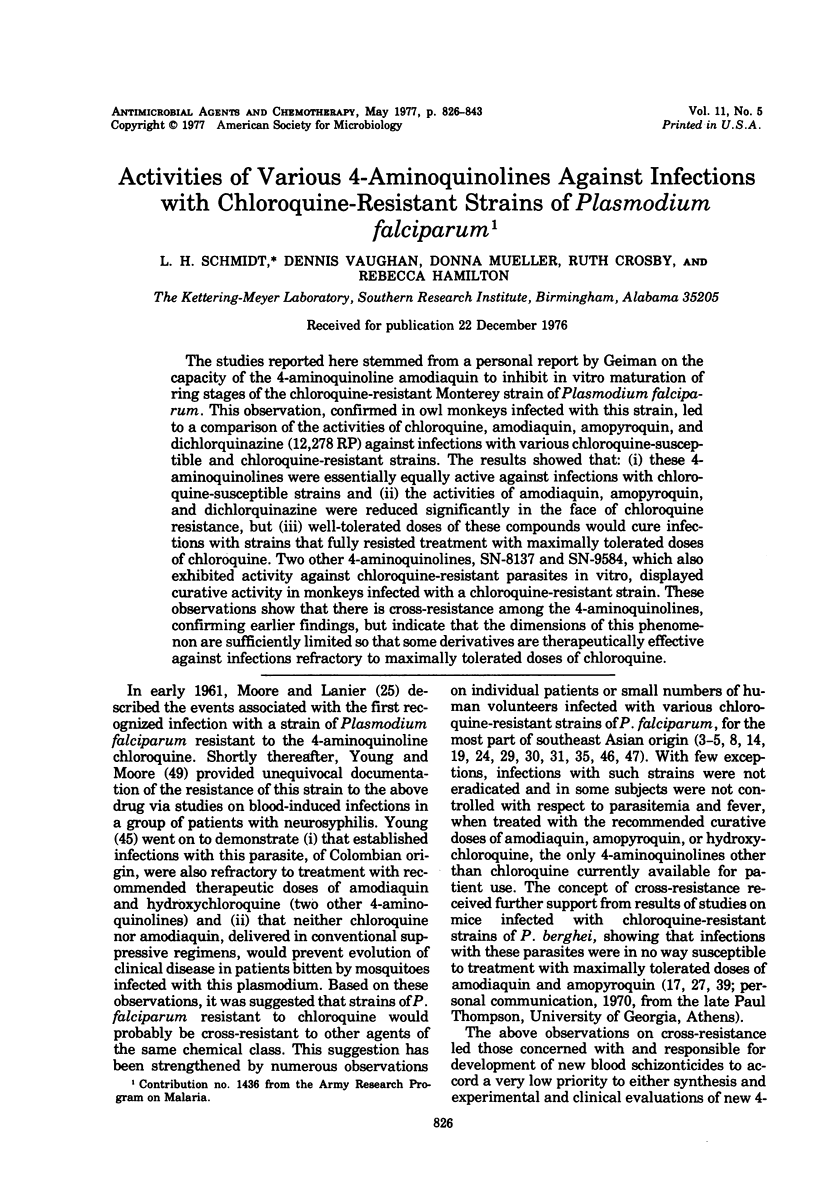
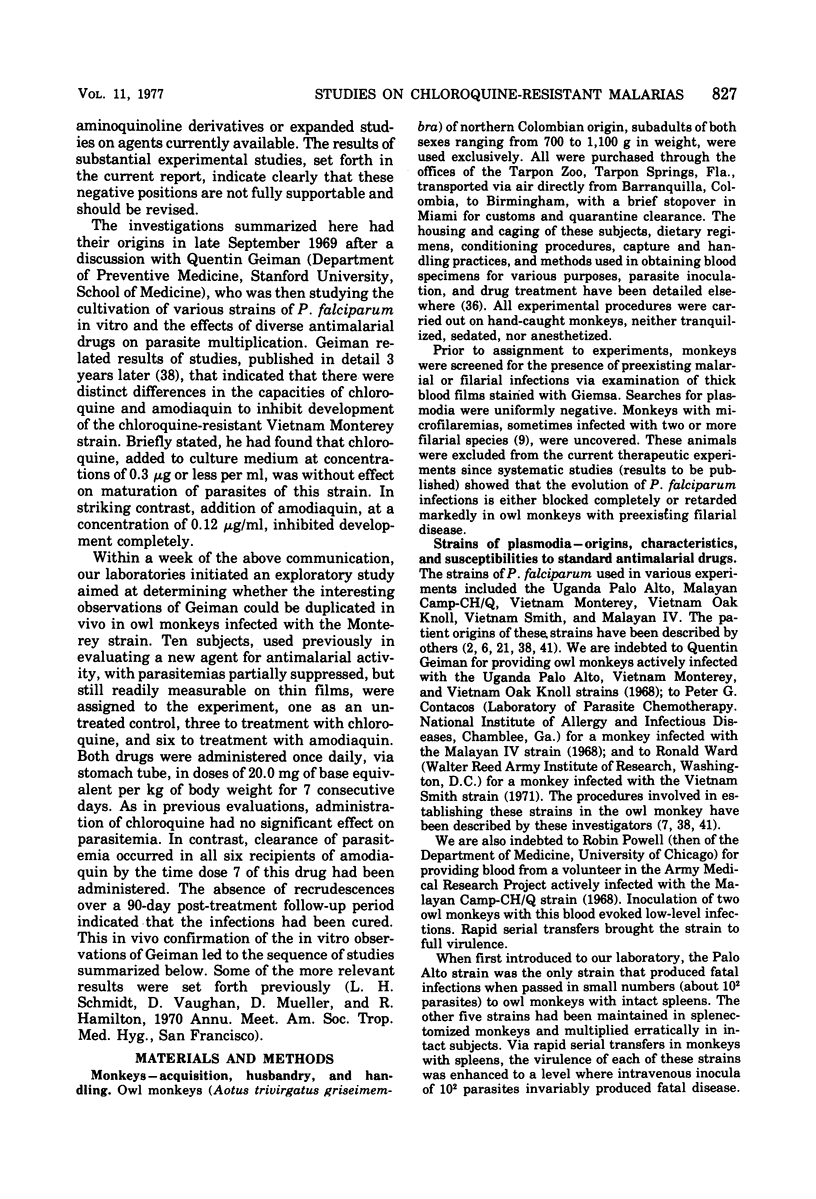
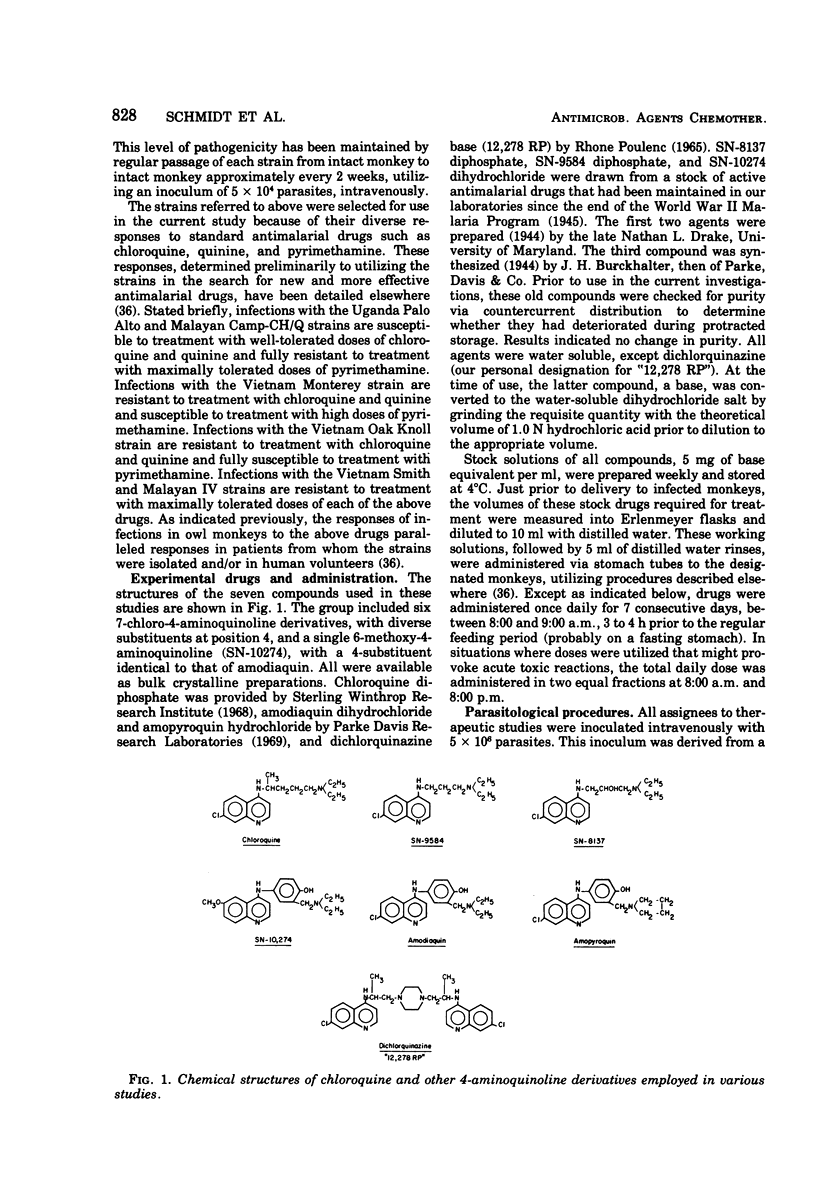
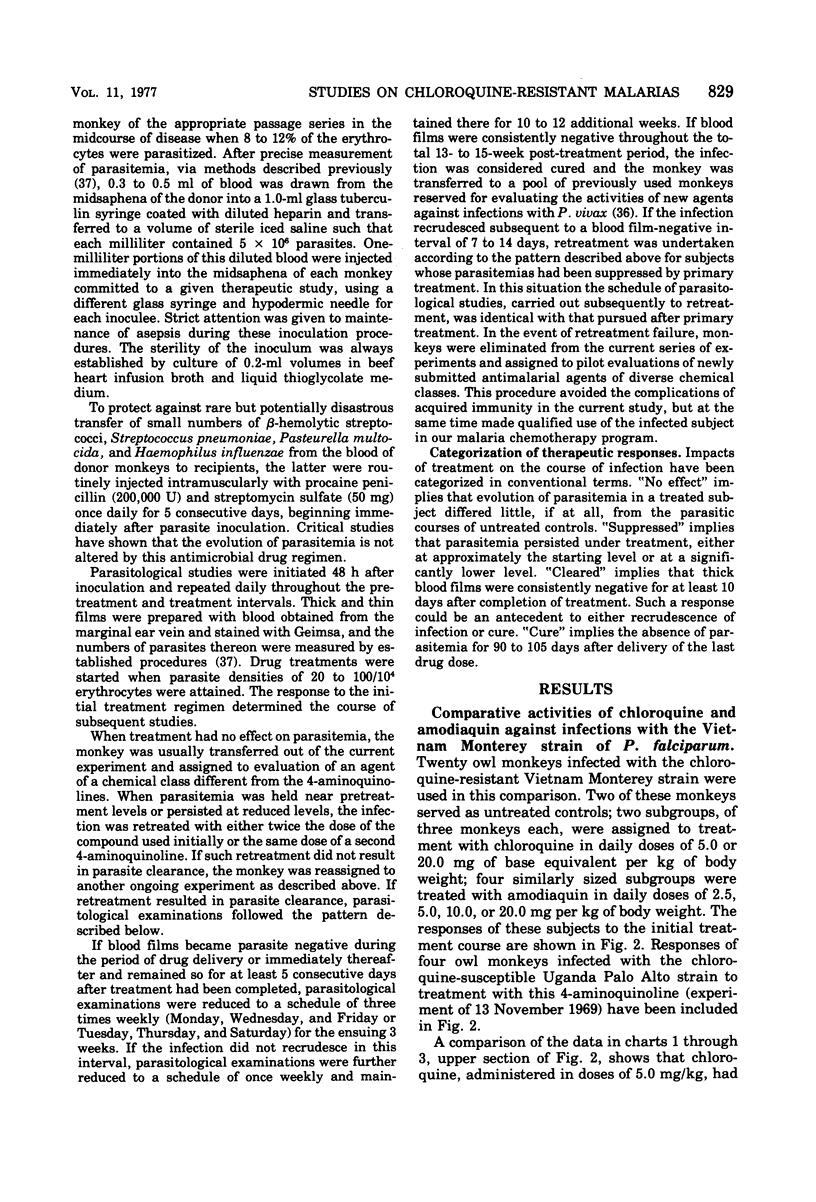
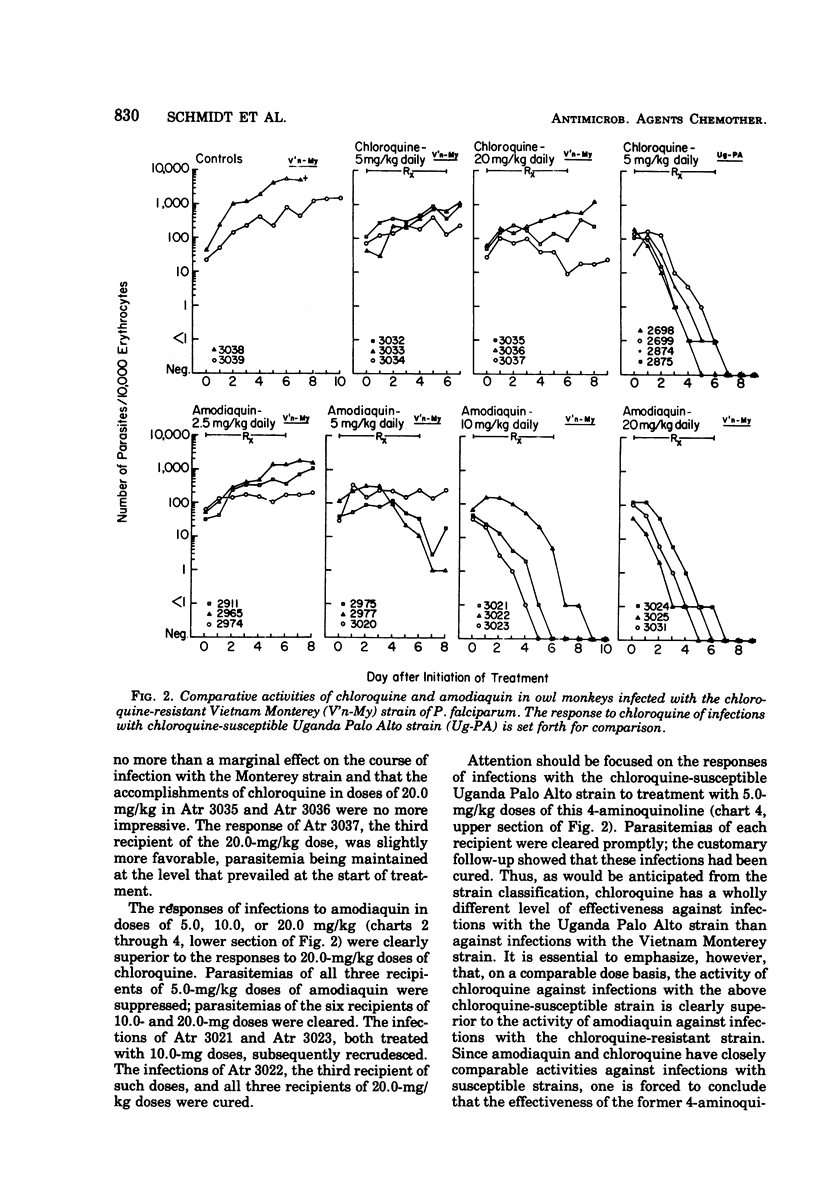
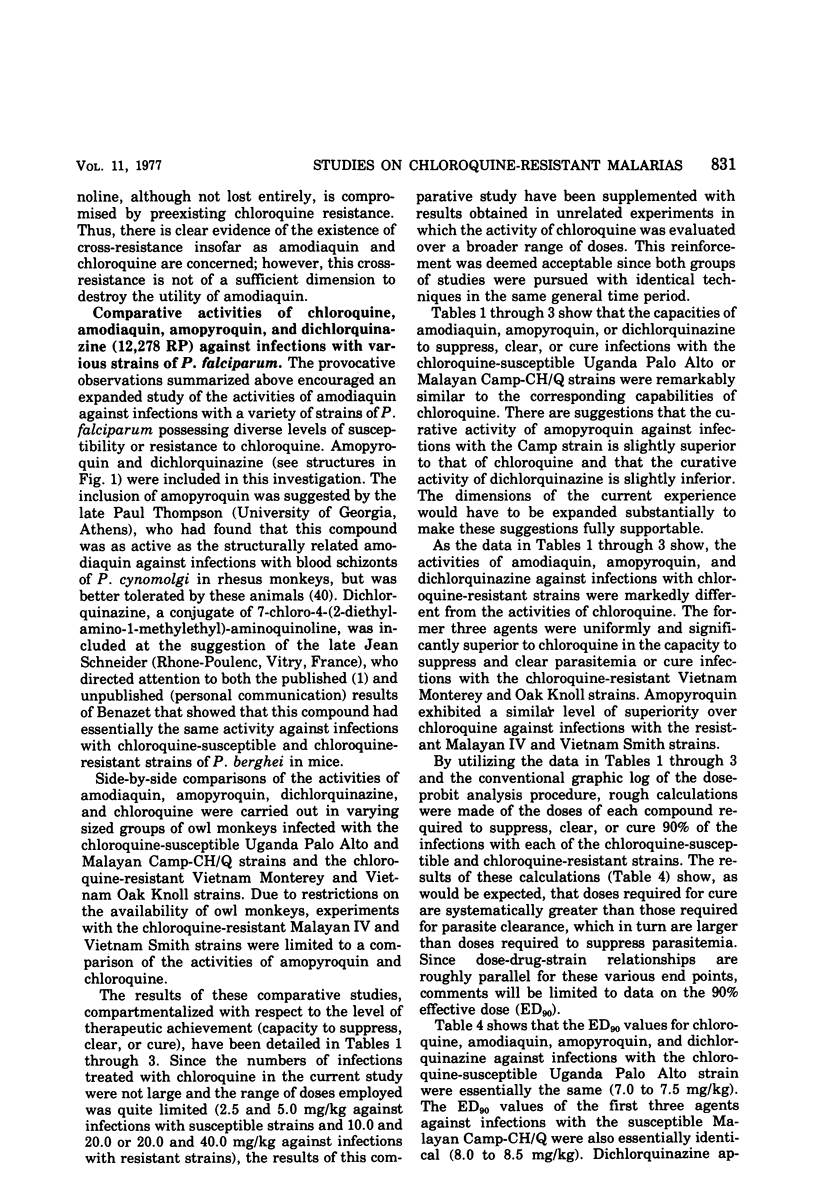
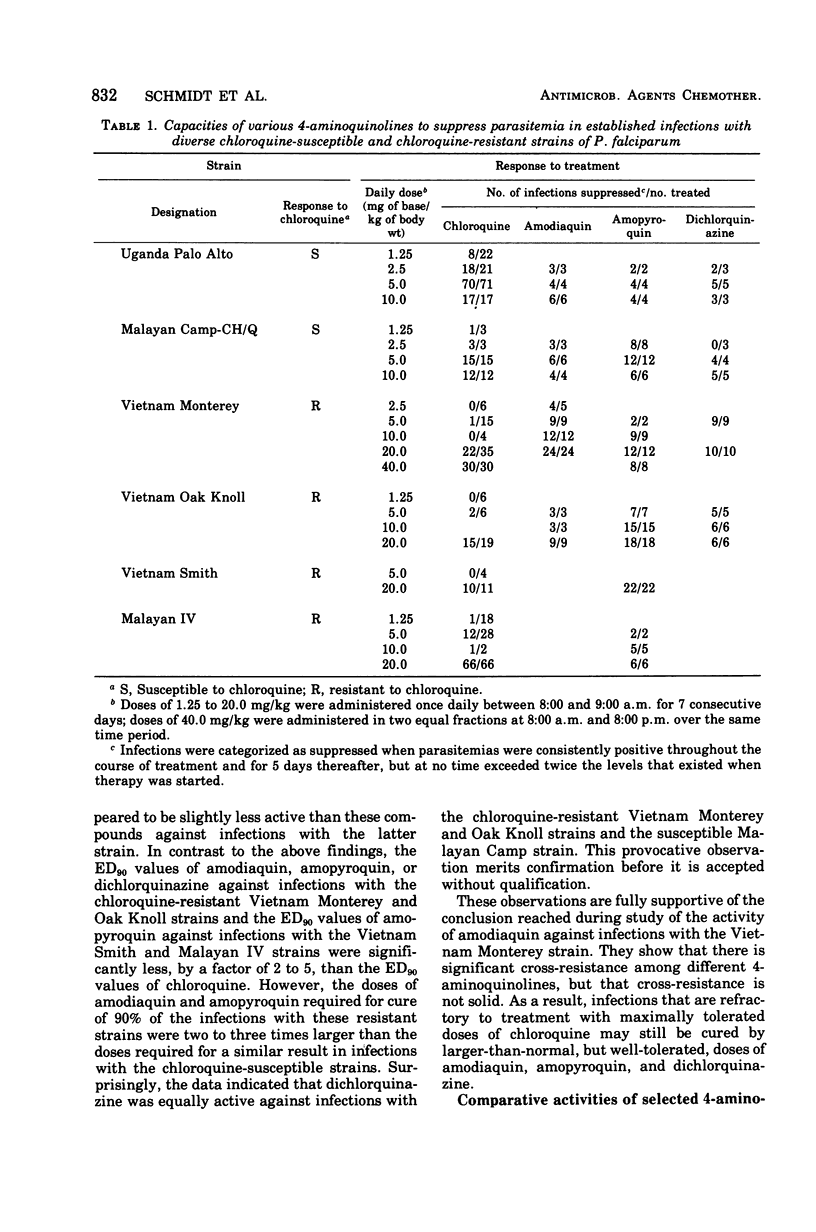
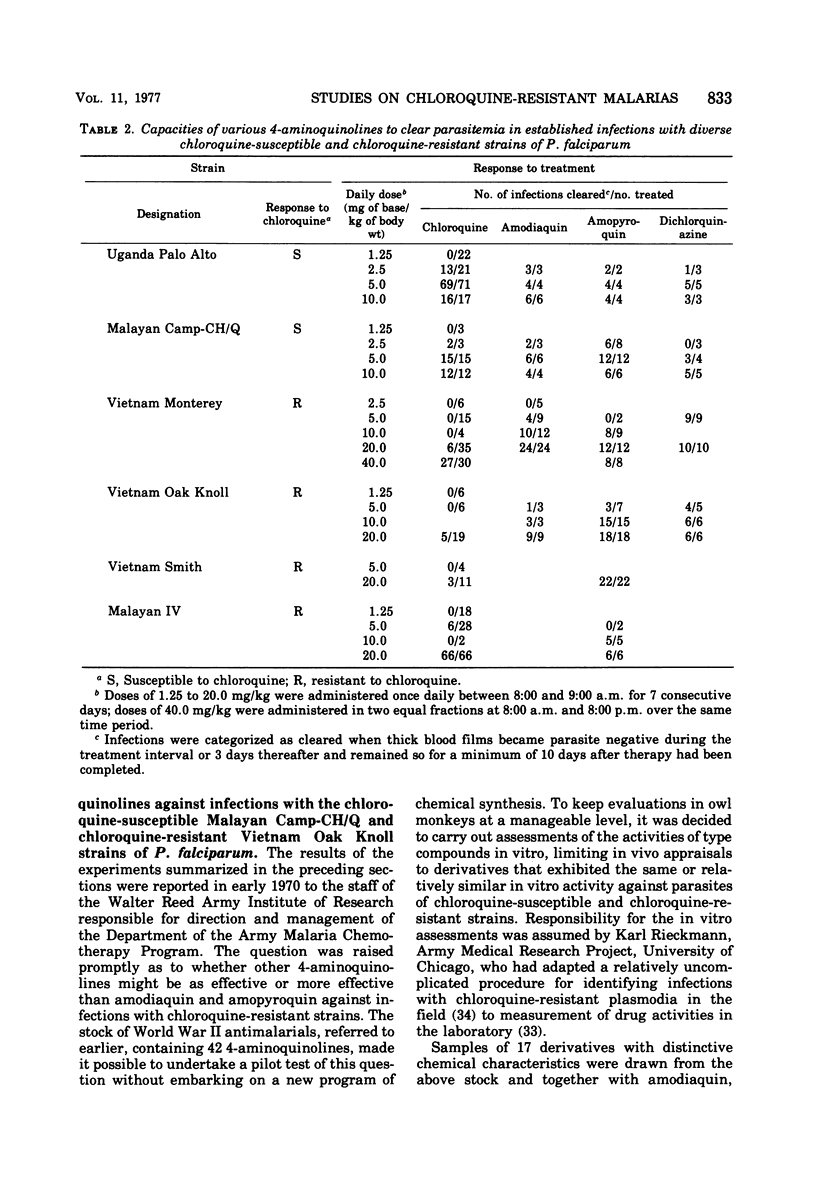
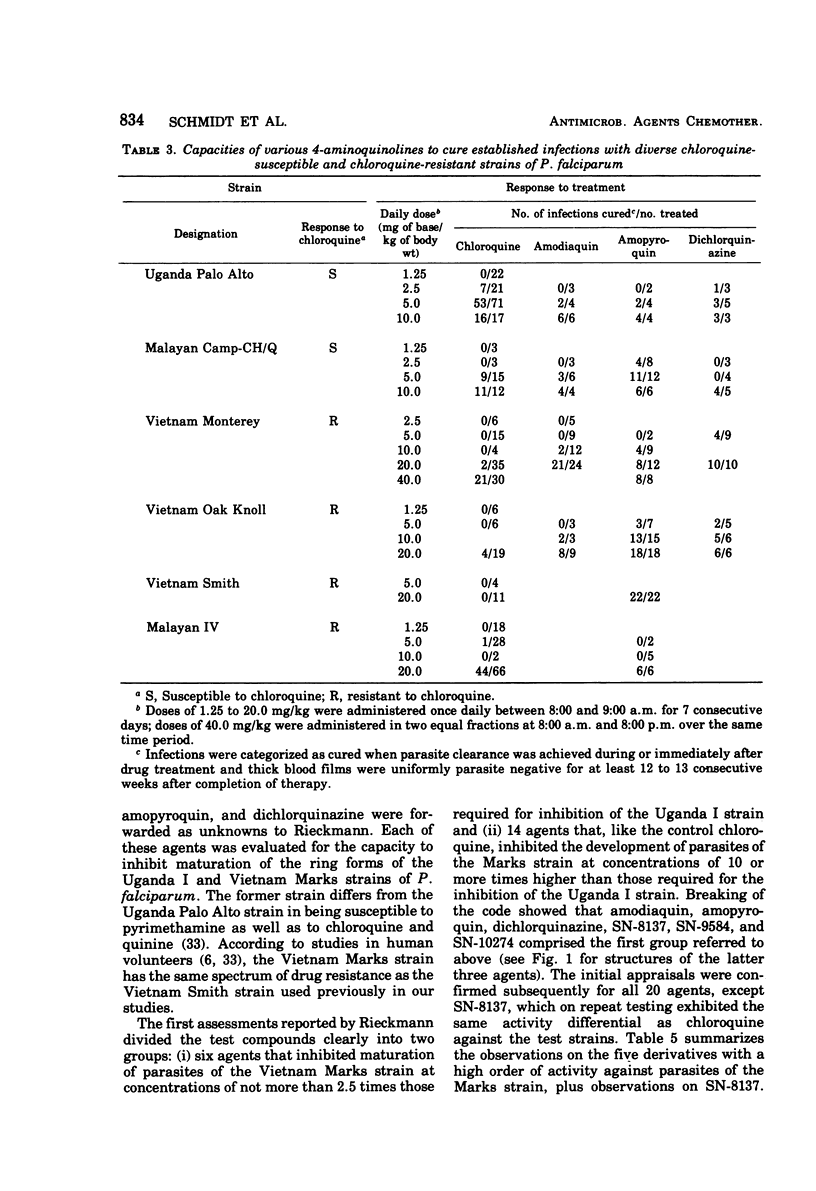
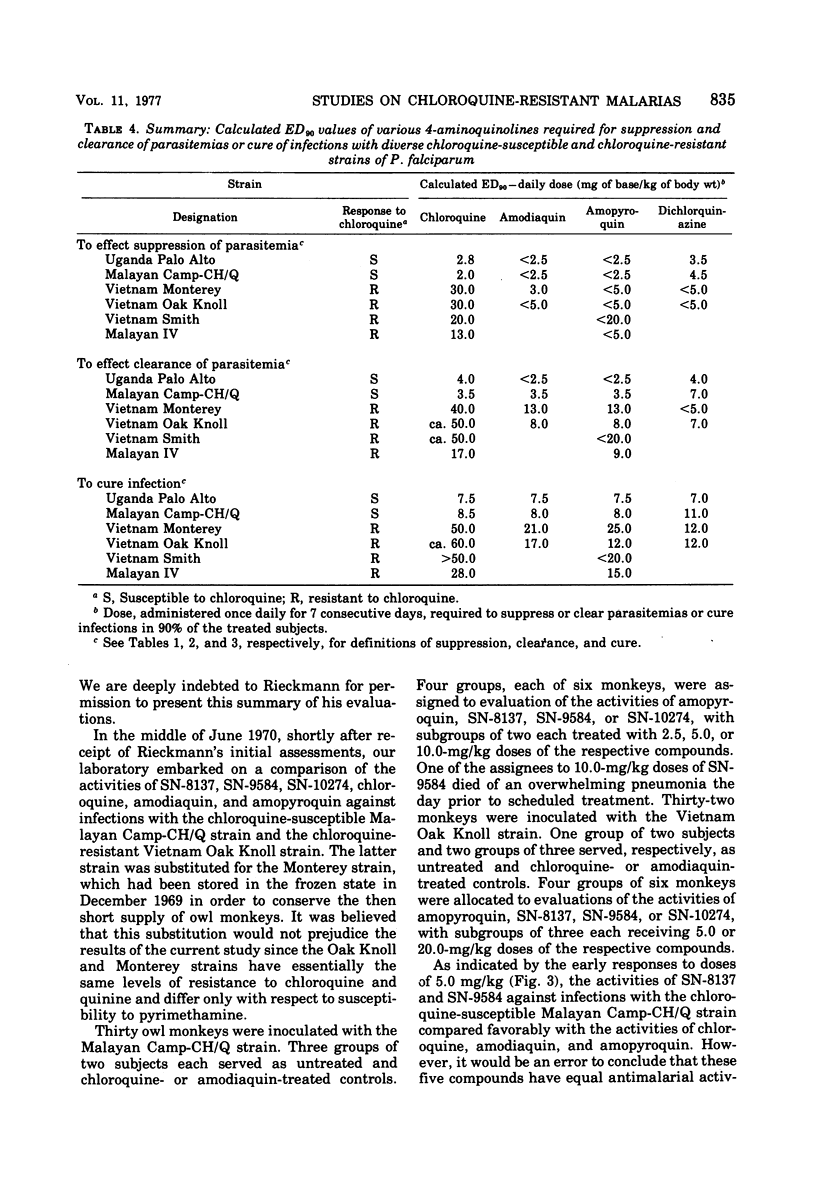
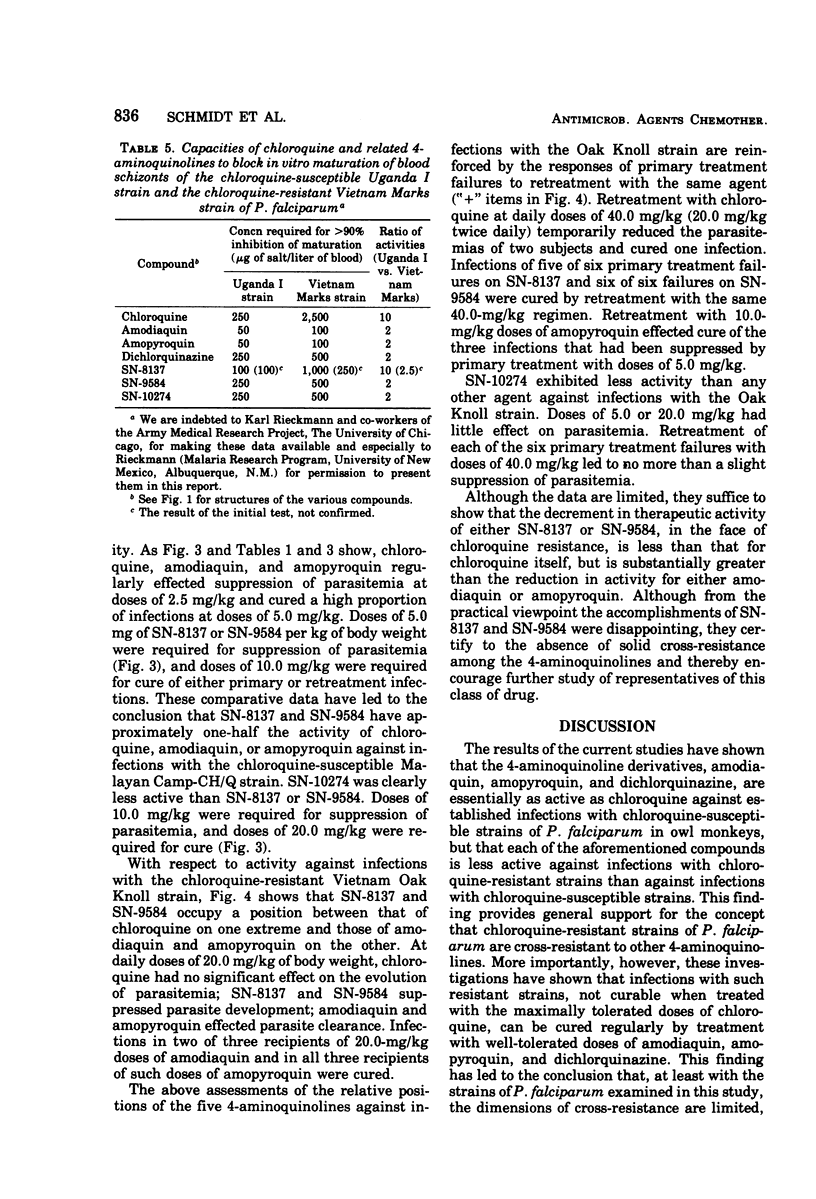
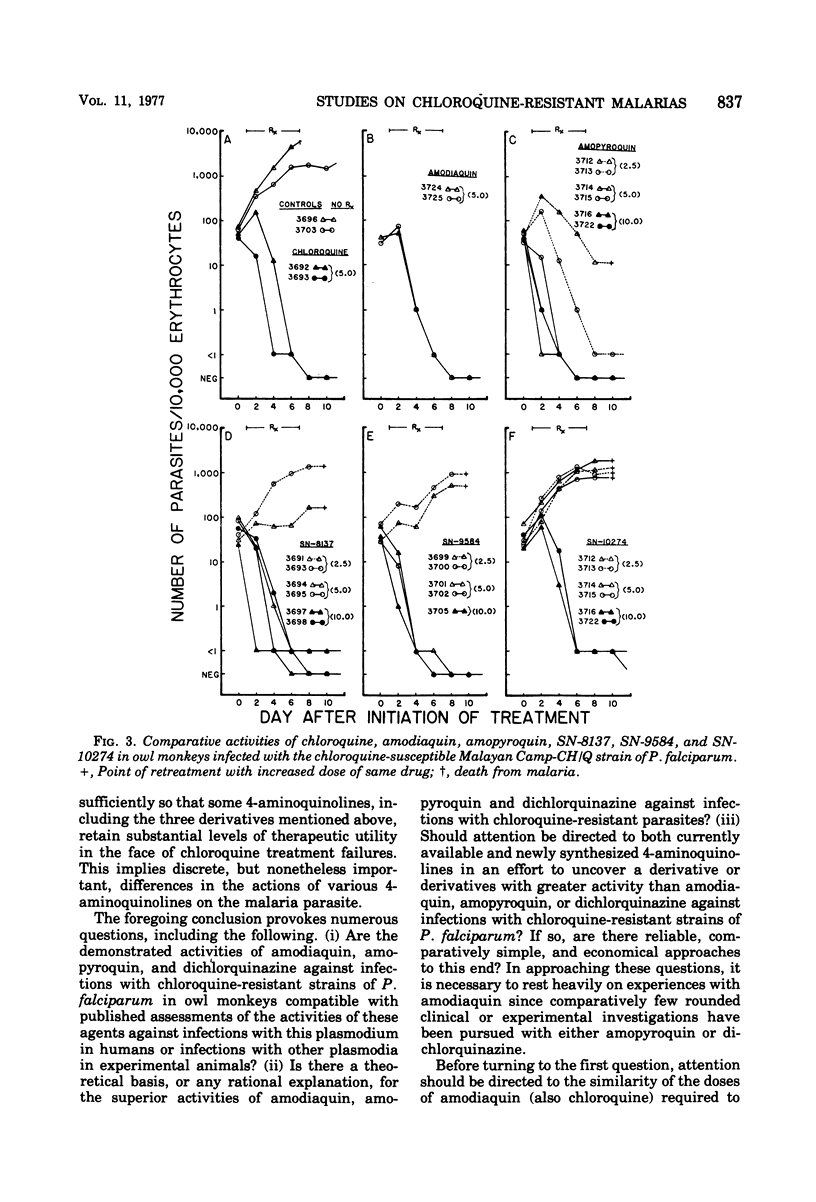
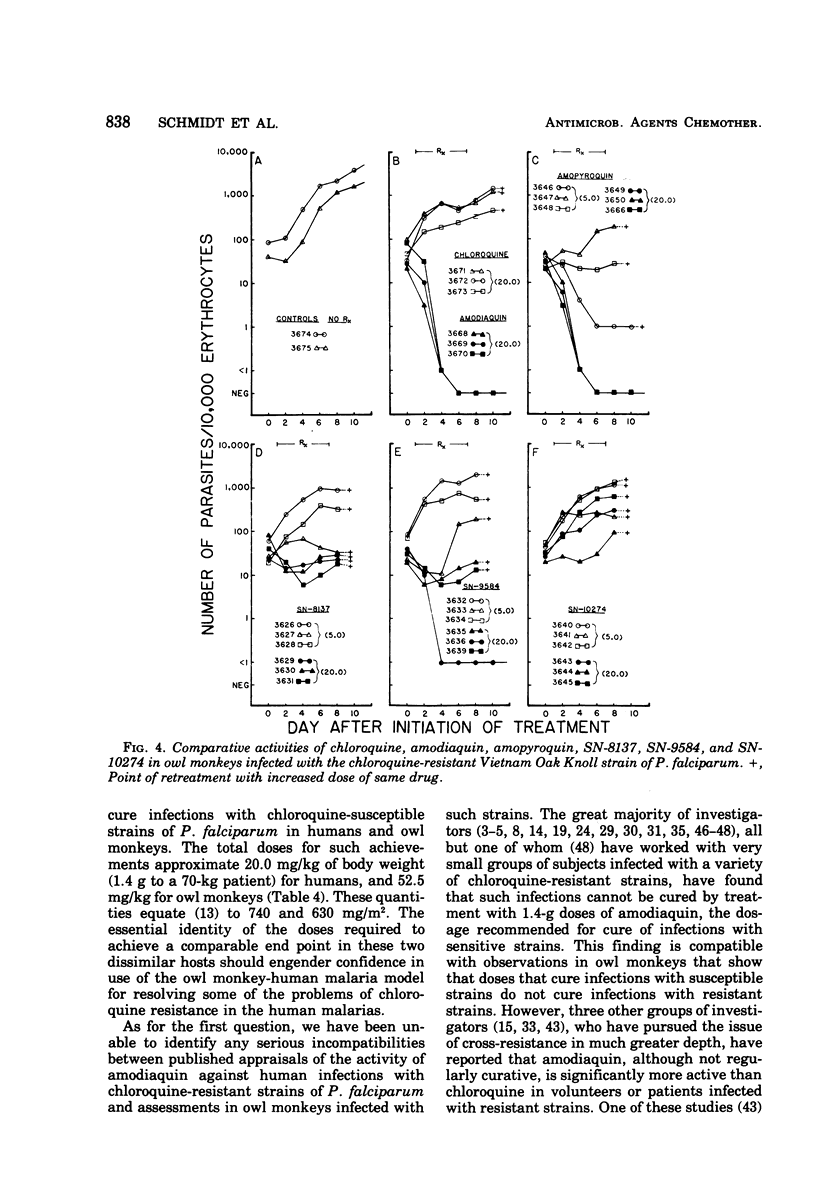
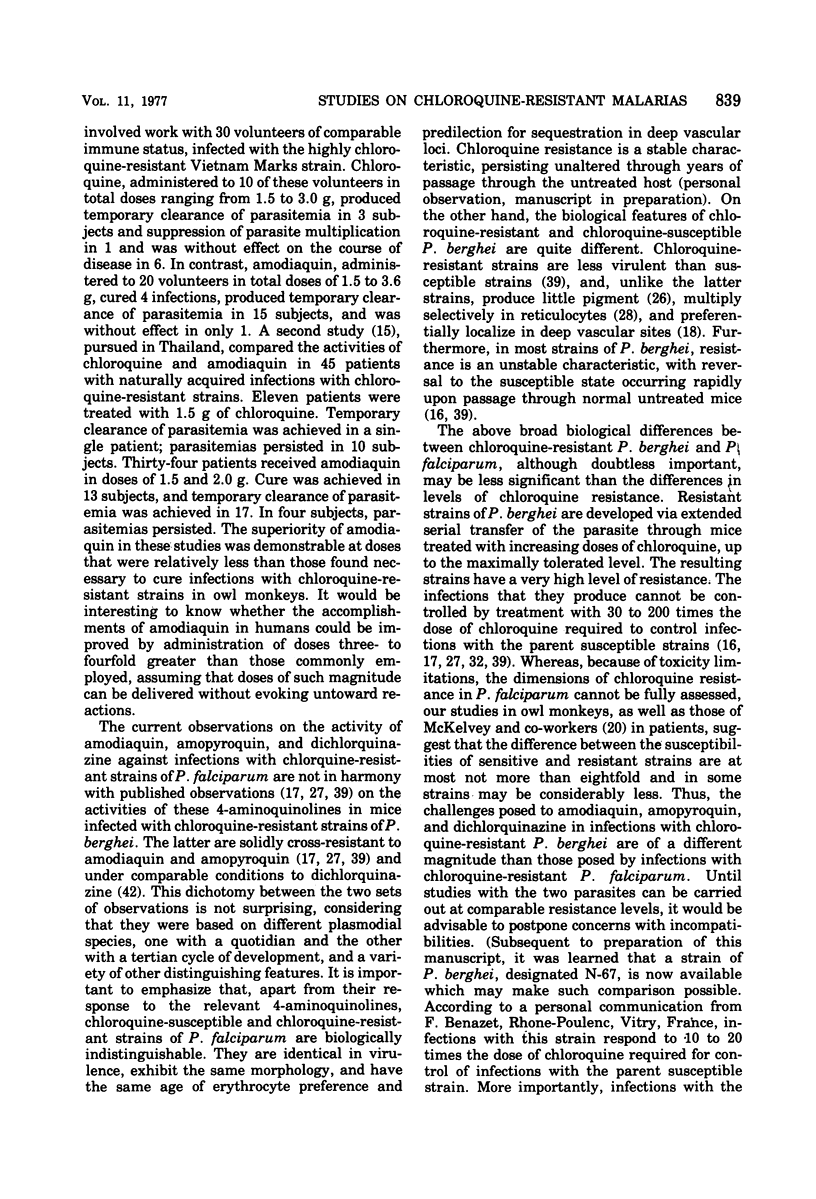
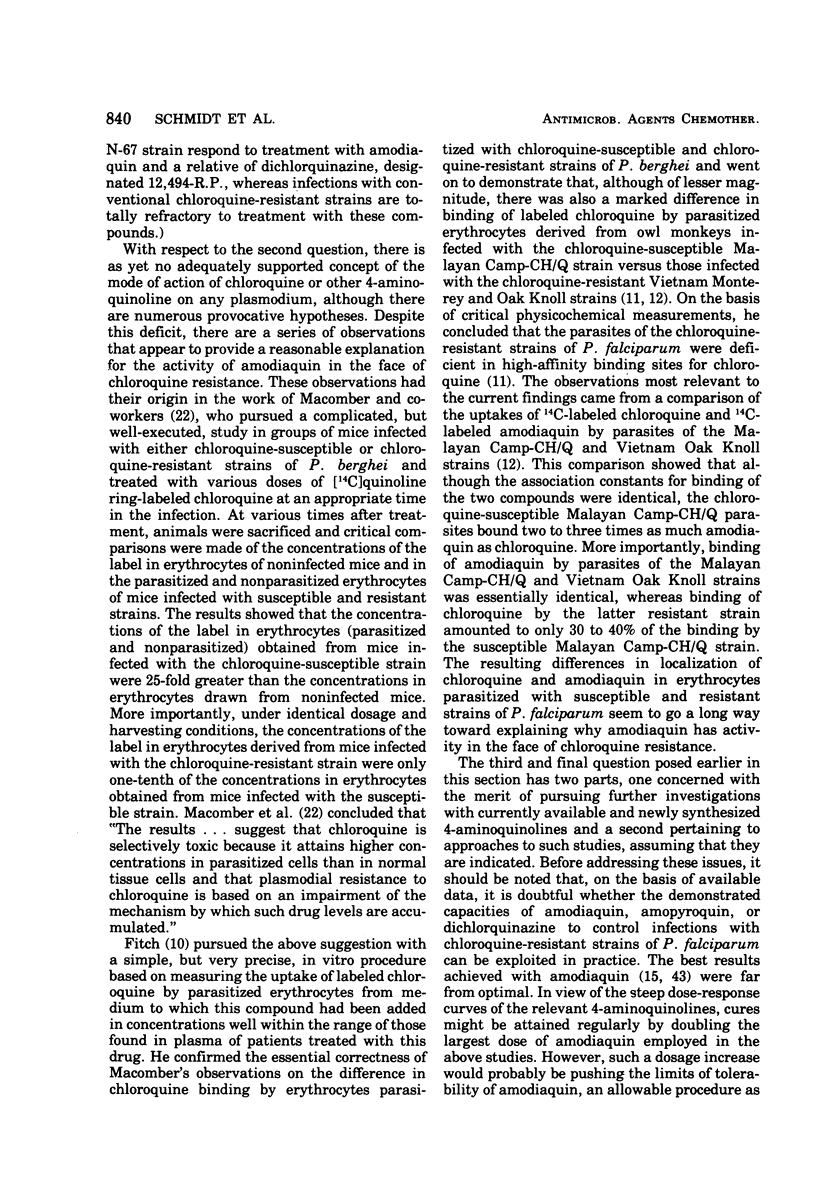
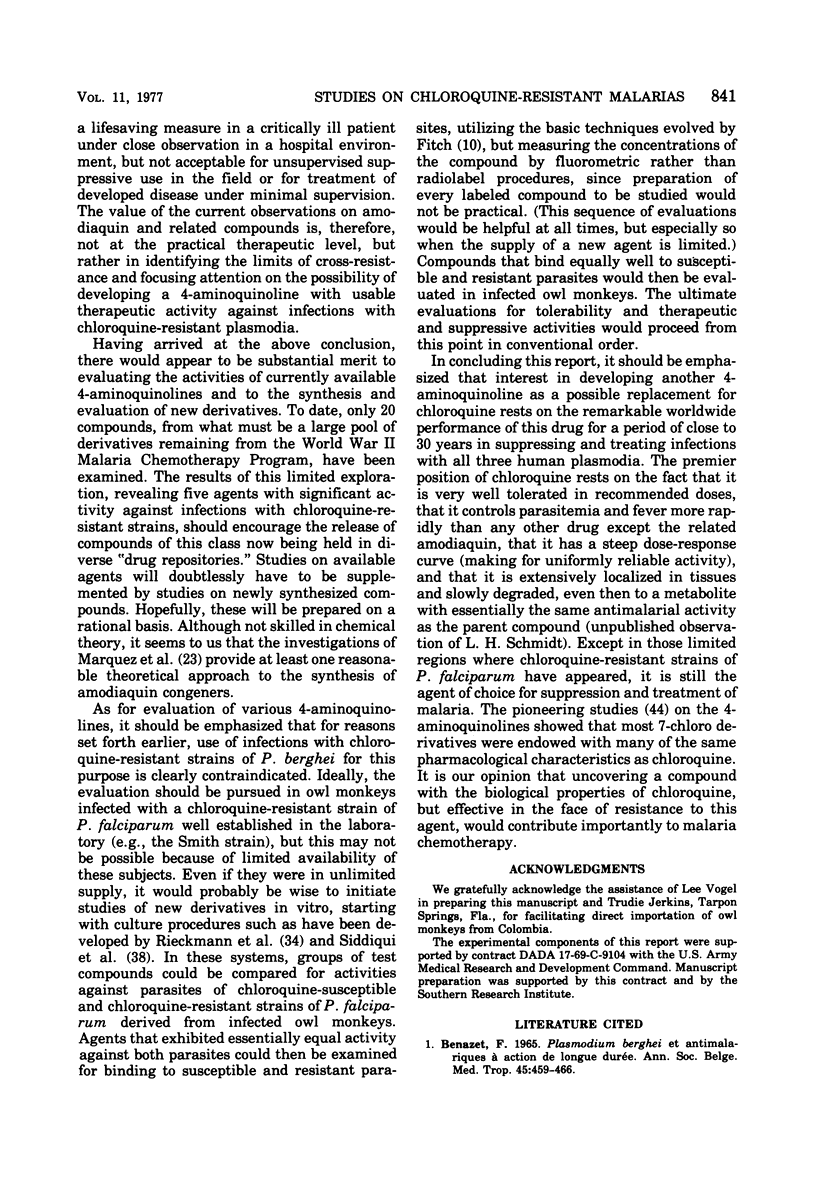
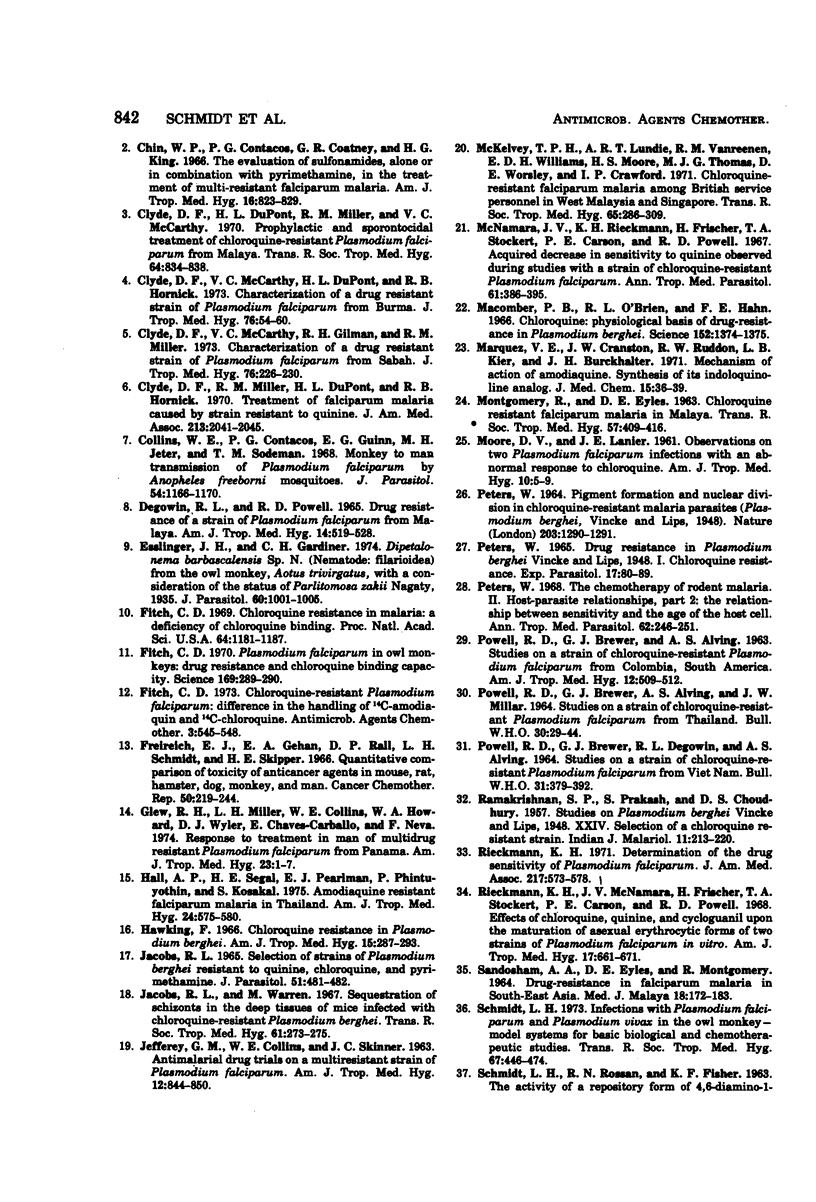
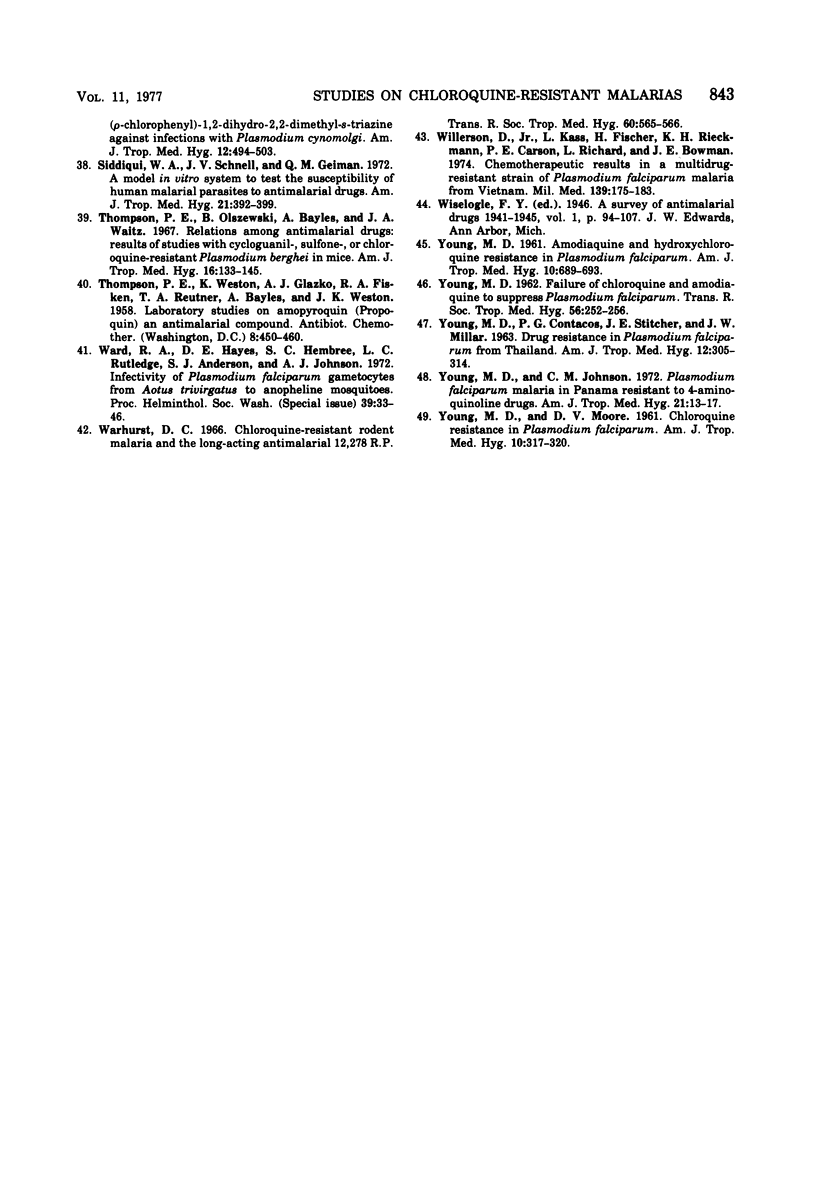
Selected References
These references are in PubMed. This may not be the complete list of references from this article.
- Benazet F. Plasmodium berghei et antimalariques à action de longue durée. Ann Soc Belges Med Trop Parasitol Mycol. 1965;45(4):459–472. [PubMed] [Google Scholar]
- Chin W., Contacos P. G., Coatney G. R., King H. K. The evaluation of sulfonamides, alone or in combination with pyrimethamine, in the treatment of multi-resistant falciparum malaria. Am J Trop Med Hyg. 1966 Nov;15(6):823–829. doi: 10.4269/ajtmh.1966.15.823. [DOI] [PubMed] [Google Scholar]
- Clyde D. F., DuPont H. L., Miller R. M., McCarthy V. C. Prophylactic and sporontocidal treatment of chloroquine resistant Plasmodium falciparum from Malaya. Trans R Soc Trop Med Hyg. 1970;64(6):834–838. doi: 10.1016/0035-9203(70)90102-1. [DOI] [PubMed] [Google Scholar]
- Clyde D. F., McCarthy V. C., DuPont H. L., Hornick R. B. Characterization of a drug resistant strain of Plasmodium falciparum from Burma. J Trop Med Hyg. 1973 Mar;76(3):54–60. [PubMed] [Google Scholar]
- Clyde D. F., McCarthy V. C., Gilman R. H., Miller R. M. Characterisation of a drug resistant strain of Plasmodium falciparum from Sabah. J Trop Med Hyg. 1973 Sep;76(9):226–230. [PubMed] [Google Scholar]
- Clyde D. F., Miller R. M., DuPont H. L., Hornick R. B. Treatment of falciparum malaria caused by strain resistant to quinine. JAMA. 1970 Sep 21;213(12):2041–2045. [PubMed] [Google Scholar]
- Collins W. E., Contacos P. G., Guinn E. G., Jeter M. H., Sodeman T. M. Monkey to man transmission of Plasmodium falciparum by Anopheles freeborni mosquitoes. J Parasitol. 1968 Dec;54(6):1166–1170. [PubMed] [Google Scholar]
- Esslinger J. H., Gardiner C. H. Dipetalonema barbascalensis sp. n. (Nematoda:Filarioidea) from the owl monkey, Aotus trivirgatus, with a consideration of the status of Parlitomosa zakii Nagaty, 1935. J Parasitol. 1974 Dec;60(6):1001–1005. [PubMed] [Google Scholar]
- Fitch C. D. Chloroquine resistance in malaria: a deficiency of chloroquine binding. Proc Natl Acad Sci U S A. 1969 Dec;64(4):1181–1187. doi: 10.1073/pnas.64.4.1181. [DOI] [PMC free article] [PubMed] [Google Scholar]
- Fitch C. D. Chloroquine-resistant Plasmodium falciparum: difference in the handling of 14C-amodiaquin and 14C-chloroquine. Antimicrob Agents Chemother. 1973 May;3(5):545–548. doi: 10.1128/aac.3.5.545. [DOI] [PMC free article] [PubMed] [Google Scholar]
- Fitch C. D. Plasmodium falciparum in owl monkeys: drug resistance and chloroquine binding capacity. Science. 1970 Jul 17;169(3942):289–290. doi: 10.1126/science.169.3942.289. [DOI] [PubMed] [Google Scholar]
- Freireich E. J., Gehan E. A., Rall D. P., Schmidt L. H., Skipper H. E. Quantitative comparison of toxicity of anticancer agents in mouse, rat, hamster, dog, monkey, and man. Cancer Chemother Rep. 1966 May;50(4):219–244. [PubMed] [Google Scholar]
- Glew R. H., Miller L. H., Collins W. E., Howard W. A., Wyler D. J., Chaves-Carballo E., Neva F. A. Response to treatment in man of multi-drug resistant Plasmodium falciparum from Panama. Am J Trop Med Hyg. 1974 Jan;23(1):1–7. doi: 10.4269/ajtmh.1974.23.1. [DOI] [PubMed] [Google Scholar]
- Hall A. P., Segal H. E., Pearlman E. J., Phintuyothin P., Kosakal S. Amodiaquine resistant falciparum malaria in Thailand. Am J Trop Med Hyg. 1975 Jul;24(4):575–580. doi: 10.4269/ajtmh.1975.24.575. [DOI] [PubMed] [Google Scholar]
- Hawking F. Chloroquine resistance in Plasmodium berghei. Am J Trop Med Hyg. 1966 May;15(3):287–293. doi: 10.4269/ajtmh.1966.15.287. [DOI] [PubMed] [Google Scholar]
- JEFFERY G. M., COLLINS W. E., SKINNER J. C. ANTIMALARIAL DRUG TRIALS ON A MULTIRESISTANT STRAIN OF PLASMODIUM FALCIPARUM. Am J Trop Med Hyg. 1963 Nov;12:844–850. doi: 10.4269/ajtmh.1963.12.844. [DOI] [PubMed] [Google Scholar]
- Jacobs R., Warren M. Sequestration of schizonts in the deep tissues of mice infected with chloroquine-resistant Plasmodium berghei. Trans R Soc Trop Med Hyg. 1967;61(2):273–275. doi: 10.1016/0035-9203(67)90170-8. [DOI] [PubMed] [Google Scholar]
- MONTGOMERY R., EYLES D. E. CHLOROQUINE RESISTANT FALCIPARUM MALARIA IN MALAYA. Trans R Soc Trop Med Hyg. 1963 Nov;57:409–416. doi: 10.1016/0035-9203(63)90073-7. [DOI] [PubMed] [Google Scholar]
- MOORE D. V., LANIER J. E. Observations on two Plasmodium falciparum infections with an abnormal response to chloroquine. Am J Trop Med Hyg. 1961 Jan;10:5–9. doi: 10.4269/ajtmh.1961.10.5. [DOI] [PubMed] [Google Scholar]
- Macomber P. B., O'Brien R. L., Hahn F. E. Chloroquine: physiological basis of drug resistance in Plasmodium berghei. Science. 1966 Jun 3;152(3727):1374–1375. doi: 10.1126/science.152.3727.1374. [DOI] [PubMed] [Google Scholar]
- Marquez V. E., Cranston J. W., Ruddon R. W., Kier L. B., Burckhalter J. H. Mechanism of action of amodiaquine. Synthesis of its indoloquinoline analog. J Med Chem. 1972 Jan;15(1):36–39. doi: 10.1021/jm00271a010. [DOI] [PubMed] [Google Scholar]
- McKelvey T. P., Lundie A. R., Vanreenen R. M., Williams E. D., Moore H. S., Thomas M. J., Worsley D. E., Crawford I. P. Chloroquine-resistant falciparum malaria among British service personnel in West Malaysia and Singapore. Trans R Soc Trop Med Hyg. 1971;65(3):286–309. doi: 10.1016/0035-9203(71)90003-4. [DOI] [PubMed] [Google Scholar]
- McNamara J. V., Rieckmann K. H., Frischer H., Stockert T. A., Carson P. E., Powell R. D. Acquired decrease in sensitivity to quinine observed during studies with a strain of chloroquine-resistant Plasmodium falciparum. Ann Trop Med Parasitol. 1967 Dec;61(4):386–395. doi: 10.1080/00034983.1967.11686504. [DOI] [PubMed] [Google Scholar]
- PETERS W. PIGMENT FORMATION AND NUCLEAR DIVISION IN CHLOROQUINE-RESISTANT MALARIA PARASITES (PLASMODIUM BERGHEI, VINCKE AND LIPS, 1948). Nature. 1964 Sep 19;203:1290–1291. doi: 10.1038/2031290a0. [DOI] [PubMed] [Google Scholar]
- POWELL R. D., BREWER G. J., ALVING A. S., MILLAR J. W. STUDIES ON A STRAIN OF CHLOROQUINE-RESISTANT PLASMODIUM FALCIPARUM FROM THAILAND. Bull World Health Organ. 1964;30:29–44. [PMC free article] [PubMed] [Google Scholar]
- POWELL R. D., BREWER G. J., ALVING A. S. STUDIES ON A STRAIN OF CHLOROQUINE-RESISTANT PLASMODIUM FALCIPARUM FROM COLOMBIA, SOUTH AMERICA. Am J Trop Med Hyg. 1963 Jul;12:509–512. doi: 10.4269/ajtmh.1963.12.509. [DOI] [PubMed] [Google Scholar]
- POWELL R. D., BREWER G. J., DEGOWIN R. L., ALVING A. S. STUDIES ON A STRAIN OF CHLOROQUINE-RESISTANT PLASMODIUM FALCIPARUM FROM VIET-NAM. Bull World Health Organ. 1964;31:379–392. [PMC free article] [PubMed] [Google Scholar]
- Peters W. Drug resistance in Plasmodium berghei Vincke and Lips, 1948. I. Chloroquine resistance. Exp Parasitol. 1965 Aug;17(1):80–89. doi: 10.1016/0014-4894(65)90012-3. [DOI] [PubMed] [Google Scholar]
- Peters W. The chemotherapy of rodent malaria. II. Host-parasite relationships. 2. The relationship between chloroquine sensitivity and the age of the host cell. Ann Trop Med Parasitol. 1968 Jun;62(2):246–261. [PubMed] [Google Scholar]
- RAMAKRISHNAN S. P., PRAKASH S., CHOUDHURY D. S. Studies on Plasmodium berghei Vincke and Lips, 1948. XXIV. Selection of a chloroquine resistant strain. Indian J Malariol. 1957 Jun;11(2):213–220. [PubMed] [Google Scholar]
- Rieckmann K. H. Determination of the drug sensitivity of Plasmodium falciparum. JAMA. 1971 Aug 2;217(5):573–578. [PubMed] [Google Scholar]
- Rieckmann K. H., McNamara J. V., Frischer H., Stockert T. A., Carson P. E., Powell R. D. Effects of chloroquine, quinine, and cycloguanil upon the maturation of asexual erythrocytic forms of two strains of Plasmodium falciparum in vitro. Am J Trop Med Hyg. 1968 Sep;17(5):661–671. doi: 10.4269/ajtmh.1968.17.661. [DOI] [PubMed] [Google Scholar]
- SANDOSHAM A. A., EYLES D. E., MONTGOMERY R. DRUG-RESISTANCE IN FALCIPARUM MALARIA IN SOUTH-EAST ASIA. Med J Malaya. 1964 Mar;18:172–183. [PubMed] [Google Scholar]
- SCHMIDT L. H., ROSSAN R. N., FISHER K. F. THE ACTIVITY OF A REPOSITORY FORM OF 4,6-DIAMINO-1(P-CHLOROPHENYL)-1,2-DIHYDRO-2,2-DIMETHYL-S-TRIAZINE AGAINST INFECTIONS WITH PLASMODIUM CYNOMOLGI. Am J Trop Med Hyg. 1963 Jul;12:494–503. doi: 10.4269/ajtmh.1963.12.494. [DOI] [PubMed] [Google Scholar]
- Schmidt L. H. Infections with Plasmodium falciparum and Plasmodium vivax in the owl monkey--model systems for basic biological and chemotherapeutic studies. Trans R Soc Trop Med Hyg. 1973;67(4):446–474. doi: 10.1016/0035-9203(73)90077-1. [DOI] [PubMed] [Google Scholar]
- Siddiqui W. A., Schnell J. V., Geiman Q. M. A model in vitro system to test the susceptibility of human malarial parasites to antimalarial drugs. Am J Trop Med Hyg. 1972 Jul;21(4):393–399. [PubMed] [Google Scholar]
- Thompson P. E., Olszewski B., Bayles A., Waitz J. A. Relations among antimalarial drugs: results of studies with cycloguanil-, sulfone-, or chloroquine-resistant Plasmodium berghei in mice. Am J Trop Med Hyg. 1967 Mar;16(2):133–145. doi: 10.4269/ajtmh.1967.16.133. [DOI] [PubMed] [Google Scholar]
- Willerson D., Jr, Rieckmann K. H., Kass L., Carson P. E., Frischer H., Richard L., Bowman J. E. Chemotherapeutic results in a multi-drug resistant strain of Plasmodium falciparum malaria from Vietnam. Mil Med. 1974 Mar;139(3):175–182. [PubMed] [Google Scholar]
- YOUNG M. D. Amodiaquine and hydroxychloroquine resistance in Plasmodium falciparum. Am J Trop Med Hyg. 1961 Sep;10:689–693. doi: 10.4269/ajtmh.1961.10.689. [DOI] [PubMed] [Google Scholar]
- YOUNG M. D., CONTACOS P. G., STITCHER J. E., MILLAR J. W. DRUG RESISTANCE IN PLASMODIUM FALCIPARUM FROM THAILAND. Am J Trop Med Hyg. 1963 May;12:305–314. doi: 10.4269/ajtmh.1963.12.305. [DOI] [PubMed] [Google Scholar]
- YOUNG M. D. Failure of chloroquine and amodiaquine to suppress Plasmodium falciparum. Trans R Soc Trop Med Hyg. 1962 May;56:252–256. doi: 10.1016/0035-9203(62)90164-5. [DOI] [PubMed] [Google Scholar]
- YOUNG M. D., MOORE D. V. Chloroquine resistance in Plasmodium falciparum. Am J Trop Med Hyg. 1961 May;10:317–320. doi: 10.4269/ajtmh.1961.10.317. [DOI] [PubMed] [Google Scholar]
- Young M. D., Johnson C. M. Plasmodium falciparum malaria in Panama resistant to 4-aminoquinoline drugs. Am J Trop Med Hyg. 1972 Jan;21(2):13–17. doi: 10.4269/ajtmh.1972.21.13. [DOI] [PubMed] [Google Scholar]


